Your Guide to Doing More Things in Greenland Besides Watching the Northern Lights
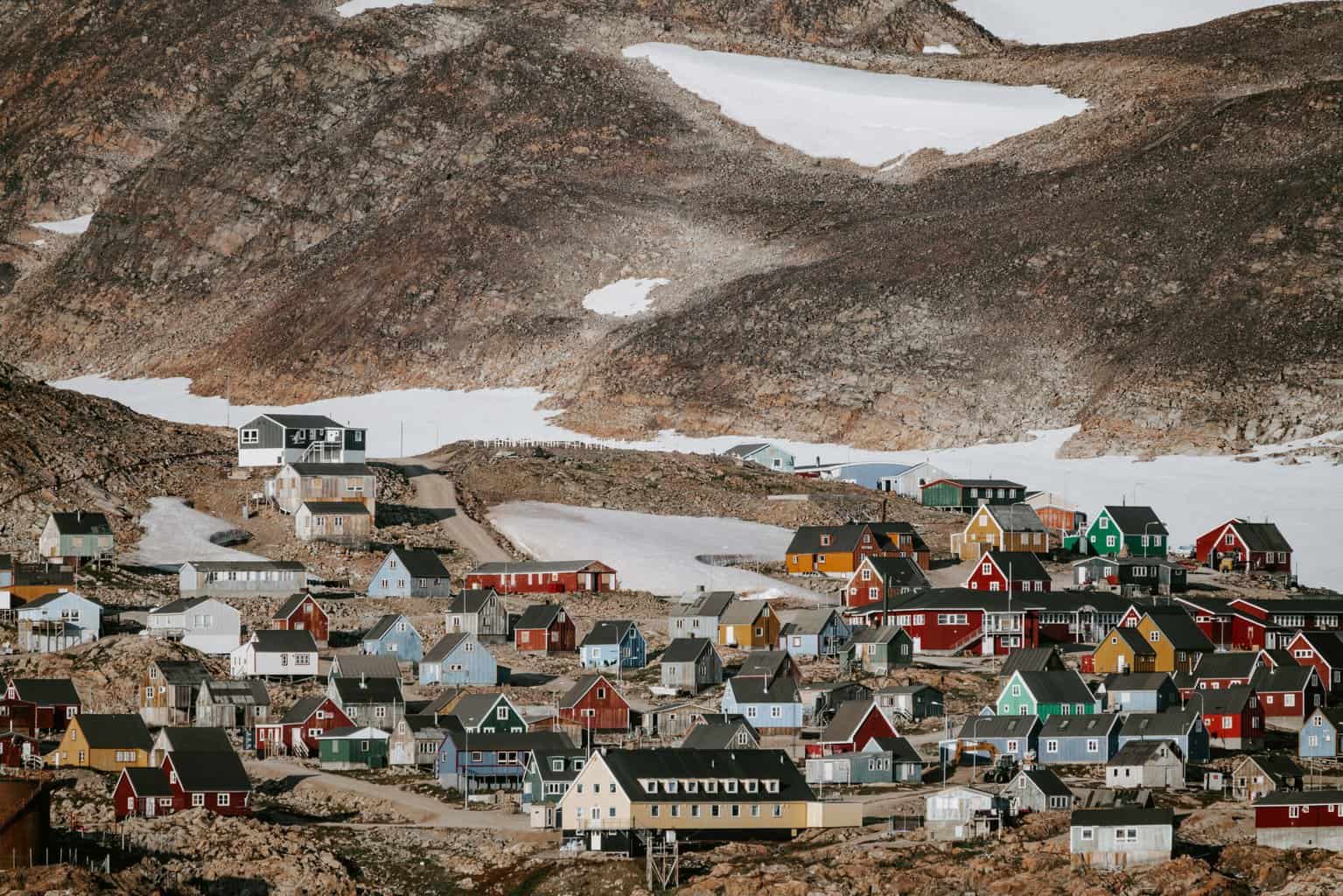
Updated On: April 26, 2024 by Noha Basiouny
People take many things into consideration when planning their overseas trips. Their destination definitely has to be affordable and reachable. But it must also excite them, like to offer experiences they long longed for, show them a unique part of the world they have not thought existed or make them go back home with loads of lovely memories that have the potential to lighten their future dull days.
In that matter, some cities, by default, happen to match many people’s travel preferences. They have been incredibly famous as terrific tourist destinations and genuinely earned their position at the top of most travellers’ bucket lists. Dubai, Paris, Sharm el-Sheikh, London, Istanbul, Amsterdam, and Seoul are just a few examples of the most visited cities in the world.
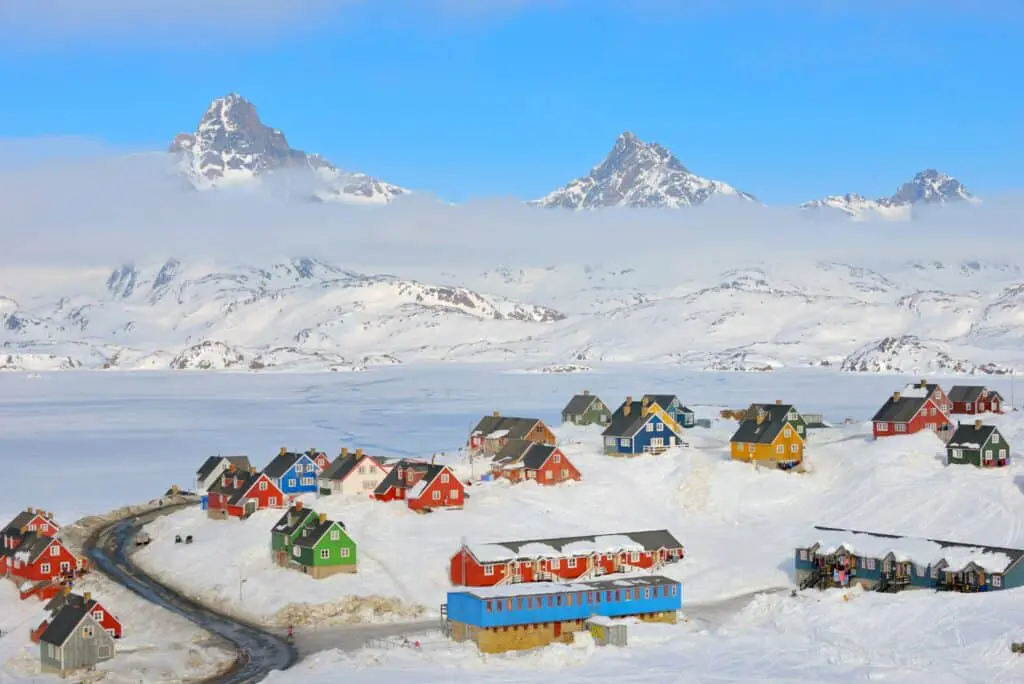
While that is nice and all, we cannot but admit that such famous places somewhat overshadow others that may not be that frequent in the media or are not known for things defined by many as tourist attractions. Like what, you are asking? Well, like Greenland, for instance.
Did you just picture gigantic bluish glaciers and icebergs floating on freezing-cold water? Some happy little indigenous kids wearing feathery hoods and smiling happily at the camera? Or maybe you know a little more about Greenland, for instance, that it is a hot spot for Northern Lights.
Well, there is more to Greenland than what most people seem to know about it, more that potentially makes it a tourist destination just perfect for your next summer vacation. So grab along a cup of coffee or your weather-matching favourite drink, and let’s go over some captivating facts about Greenland and explore some activities one can enjoy there.
Facts about Greenland
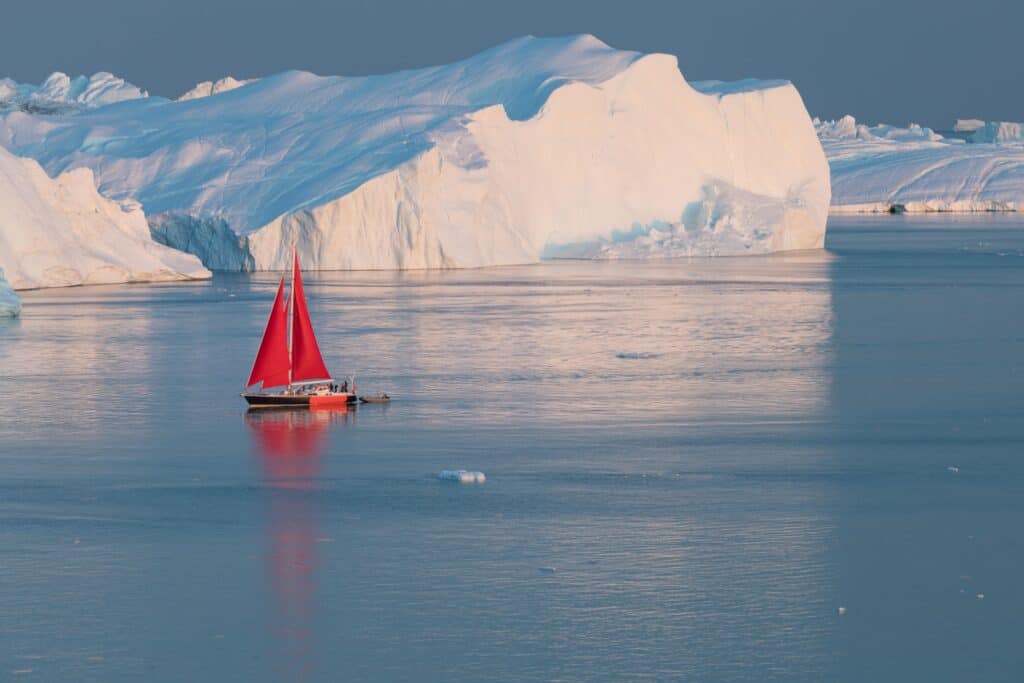
So what exactly is Greenland?
Geographically speaking, Greenland is the largest island in the entire world, with an area of 2.166 million square kilometres. It is situated in the Northern Hemisphere, floating some-freezing-where between the Arctic and the Atlantic Oceans and only less than 4,000 kilometres away from the north pole.
Oh, I hear you mumbling something about Australia being the largest island in the world. Well, that is somewhat inaccurate. According to whoever identified the different geographical concepts, an island is not one unless it is smaller than a continent. As you probably know, Australia is large enough to be a continent which disqualifies it from being an island.
Country
Greenland is actually further from Europe than North America, yet it has been more attached to the former throughout history. For instance, Norway colonised the island for over 450 years and then Denmark took control of it from the early 18th century to the mid-20th century. In 1953, Greenland was ‘added’ to Denmark and officially became part of the huge Danish realm.
Today, Greenland is an autonomous country. Although it is still not independent from the Kingdom of Denmark, it governs itself. The official language is Greenlandic, with Danish and English also being recognised.
As of 2021, the population of Greenland was estimated to be 56,653, which makes it the least populated country in the world. About 90% of the people live on the southwestern coast, while the rest reside in the northeastern part of the country.
Greenland is made of 54 settlements or towns, with only 13 of them having a population of over a thousand people. That said, so many other towns have less than 100 inhabitants. Nuuk, located on the southwestern coast, is the capital city of and most populated town in Greenland, with 19,279 people living there.
Climate
Thanks to being close to the north pole, Greenland has an arctic climate. If you are not that into geography, let me boil it down to this: the island primarily recognises only two seasons than the four ones observed in most other countries.
More specifically, there is a noticeably long winter which can pretty much start in September and continue up to April, with December to March being the peak months where temperatures drop to below zero. For the next two months, it gets less cold and a little sunny, but not sunny enough to call it spring. Summer officially starts in June and lasts some two months. During then, there is a gradual rise in the temperature that melts the snow.
Given that climate, about 80% of Greenland is covered with a gigantic ice sheet as thick as three kilometres in some areas. It is found in the middle of the island rather than the coasts. With an area of 1,710,000 square kilometres, the Greenlandic ice sheet is the second largest one after that of Antarctica, whose only residents are penguins.
Why travel to Greenland
Greenland might not be very famous among the top travel destinations thanks to the few geographical facts we just mentioned. Ironically, it is the island’s very geography that, in fact, makes it worth visiting, for it provides an entirely different experience from what most people are familiar with or expecting.
Thanks to its location near the north pole, Greenland enjoys terrific natural phenomena that are barely found anywhere else in the world. In addition, its icy nature, low population and partial disconnection from the rest of the world provide a quite distinguished travel experience.
So let’s go over some terrific activities travellers can do when in Greenland.
1. Observe the Northern Lights.
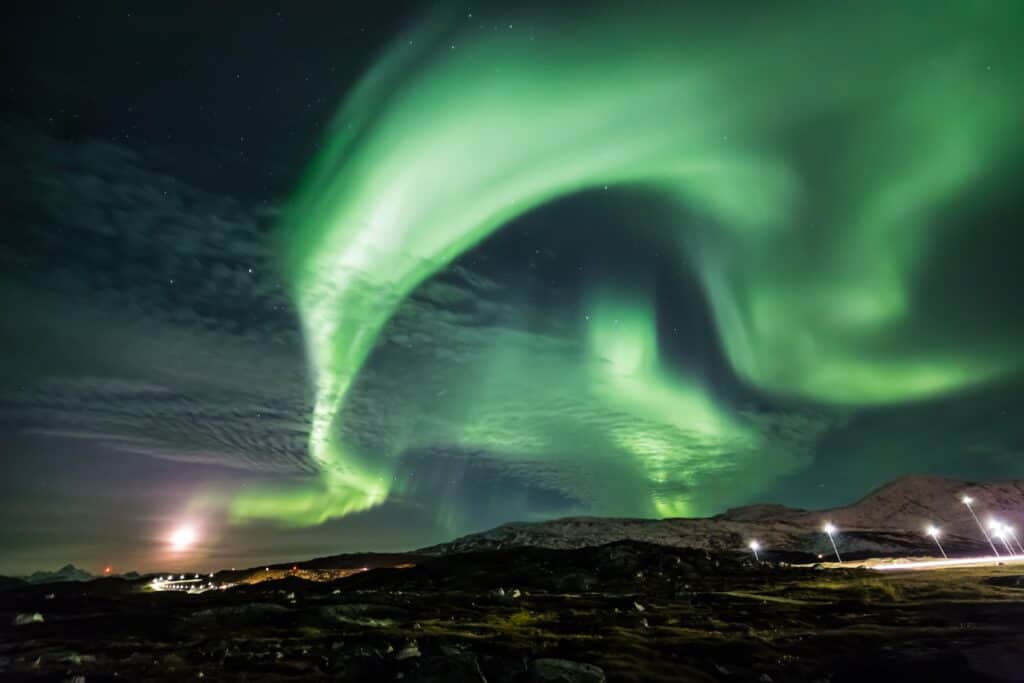
They are also known as aurora borealis or aurora for short.
One of the most beautiful natural phenomena Greenland is known for is the Northern Lights, Polar Lights or the Aurora. Put simply, these are green, purple, and blue lights that can be seen dazzling in the night sky most of the year. Interestingly, they are not only limited to the north pole but are also seen in the south pole, for they are caused by the same magnetic activity.
Here is how the Northern Lights occur, which may sound a little like a science lesson. But believe me, understanding how such a stunning phenomenon occurs makes experiencing it even more exciting and serves as a lovely reminder of the majestic Universe we live in.
Although Northern Lights occur on Earth, they actually start 151.97 million kilometres away, there at the Sun.
The Sun’s corona is the outermost part of its atmosphere, which we never get to see except during a total solar eclipse, for it is always obscured by the Sun’s light. The Sun’s atmosphere is made of hydrogen and helium, but because the corona is insanely hot, the atoms of these two gases vibrate so fast, kicking out protons and electrons.
The tremendous heat actually makes these particles move so fast that they escape from the Sun’s gravity. They then unite and form a matter called plasma. Plasma travels away from the Sun at high speed and is then called the solar wind.
When the solar wind comes across the Earth, it does not directly collide with it at a single spot as our planet’s guardian angel, the magnetosphere, distributes it over the curvature of the Earth. However, when a second wave of the solar wind hits the Earth, it overcomes the magnetosphere causing the latter to stretch and suddenly rebound, bringing some of the solar wind particles toward the Earth, precisely to the north and south poles and the areas around them.
When the electrons and protons enter our atmosphere, they run into the oxygen and nitrogen atoms and give them energy. Such collisions excite the atoms and make them emit photons, the light particles. The emitted light’s colour depends on the wavelength of the atom it is emitted from.
As it turns out, green and red lights are emitted from oxygen atoms, while nitrogen atoms produce blue and dark red light.
The Northern Lights are available year-round but best observed in a completely dark sky as they are usually dimmed by sunlight during the day. That means, to watch them, you would better visit Greenland during winter since it is sunny almost 24 hours on summer days!
2. Watch the whales.
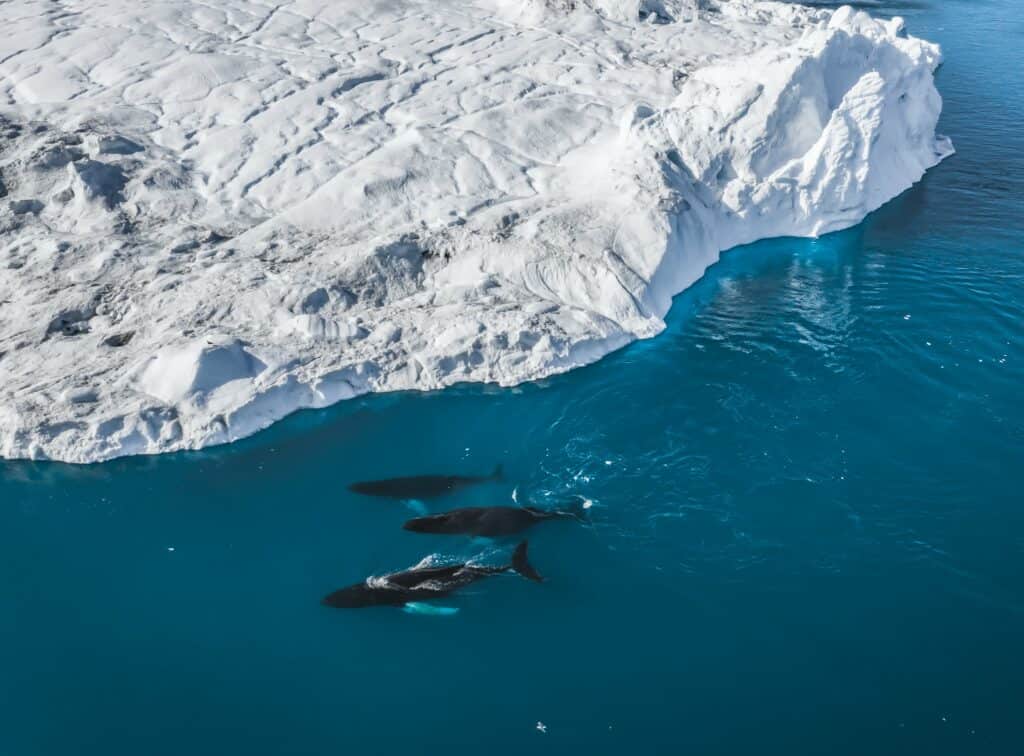
One of the most beautiful things one can do in Greenland besides watching the Northern Lights is to go on a whale-watching tour which is available in many towns on the coastline. These are guided tours organised by local companies where tourists get on boats into the ocean to watch the whales
Whale-watching is almost only available during summertime. When the temperature goes up, the ice melts, and the food becomes abundant, whales come to the local waters to feed. About 16 different species of whales can be observed, such as the fin whale, the minke whale, the humpback whale, the pilot whale and the killer whale, which is mistakenly thought to be a whale while it is actually a dolphin species, the largest of the 40 extant ones.
Watching whales in their natural habitat is such a fantastic experience. Whether they exhale and make a huge water fountain in the air, slap their fins on the water, or jump in the air and splash, all are ways whales use to communicate with other individuals and witnessing any of that is just spectacular.
3. Bathe in an ice-surrounded hot spring.
I know this does sound a bit counterintuitive, but this frozen island is actually full of natural hot springs, which provide another fantastic experience.
There are literally thousands of hot springs found all over Greenland. Yet the most famous ones are those found on the island of Uunartoq or the Warming Island, which is located off the southwestern coast and can be easily reached by boat from the town of Ilulissat.
On Uunartoq, there is a large pool that is basically three smaller hot springs that merged together. The pool is just in the centre of a great land surrounded by mountains, greens, ice and glaciers. Taking a dip in there while seeing ice all around is quite, I admit, childishly exciting!
4. Take a dog sledge.
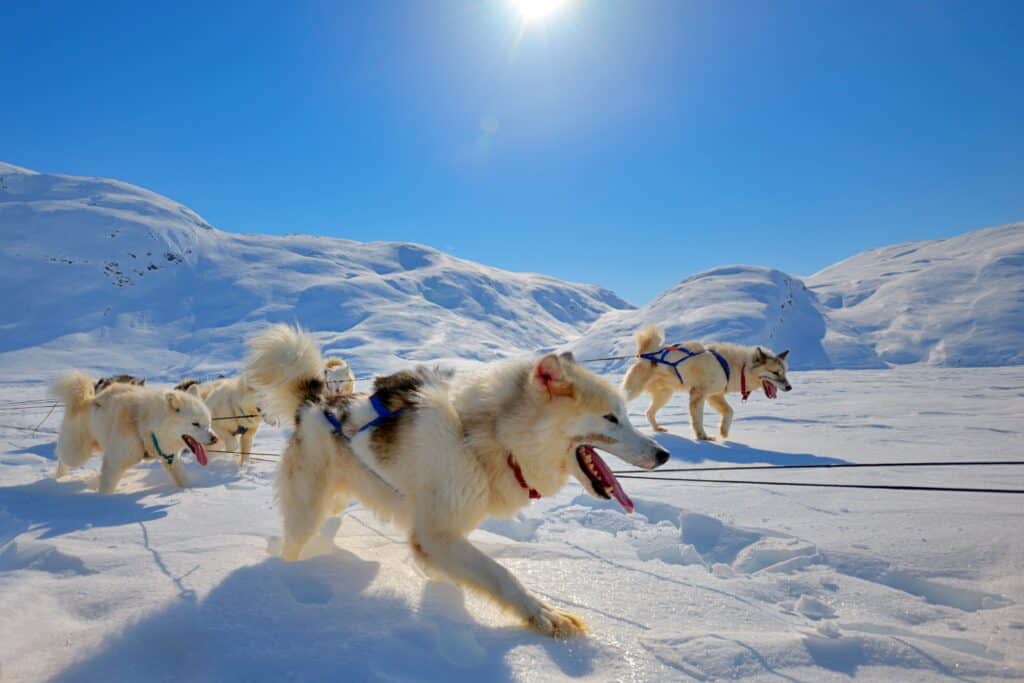
One picture almost all of us have of how people living in snow-covered places move always features a sledge pulled by either dogs or wolves. Such a thing is also widely available in Greenland and has been historically used mainly for transport and hunting.
Nowadays, it is part of the country’s identity and a traditional activity to do also for fun and exploration, which is pretty much like taking a double-decker bus to go around London.
As you may have guessed, taking a dog sledge is available almost in all towns, but only when snow is available. So this is another thing you can try if you ever make it to Greenland in winter besides watching the Northern Lights.
5. Experience the midnight sun.
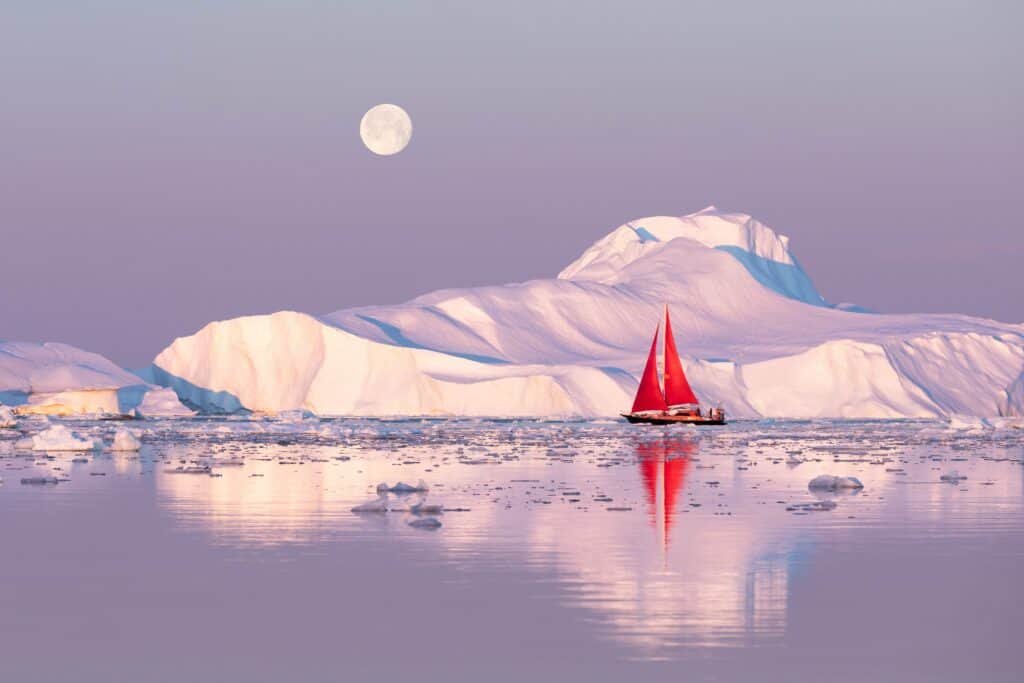
Another wonder of our dear Planet Earth, which you get to witness when in Greenland, is the midnight sun.
Since it is pretty close to the north pole, a summer day in Greenland stretches to 24 hours of continuous sunlight. Such a phenomenon happens annually for two months, from late May to late July.
Given that the majority of the Earth’s population live in places where summer days are much shorter than that, providing some space for the night to fall, witnessing the clock approaching midnight while the Sun is still in the sky is a pretty unique experience and rarely seen in most other places.
So how does this midnight sun happen anyways?
Summer days lasting for 24 hours are mainly caused by the Earth’s tilt. As the Earth rotates around the Sun, this tilt makes Greenland and the north pole have constant sunlight for two and six straight months, respectively. Basically, the Sun never sets there during these periods.
6. Experience a unique capital city.
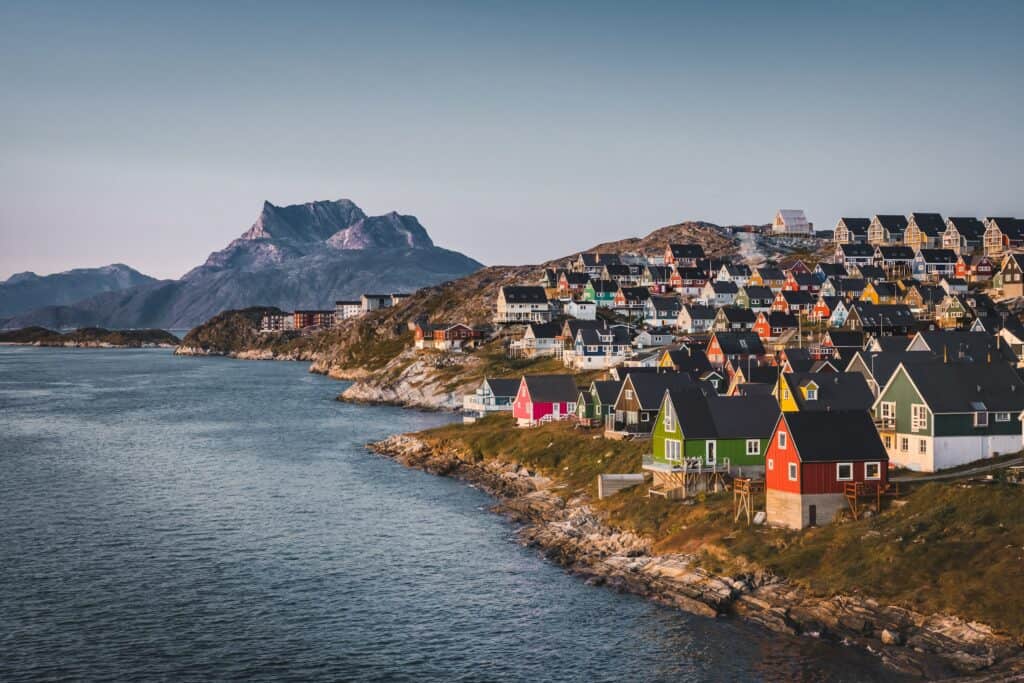
When people mostly think of capital cities, what comes to their minds is usually skyscrapers, bridges, malls, palace-like museums, buses, cars, wide clean streets but also heavy traffic, maybe parks and historic downtowns. Yet, Greenland’s capital city is nothing like that. In other words, it is everything that no one sees when visualising a capital city. However, it is pretty uniquely authentic just the way it is.
First of all, Nuuk, located on the southwest coast, is relatively small. It is only 690 square kilometres in area and has a population of 19,604 people. But it is also Greenland’s largest and most populated city.
Nuuk displays the major things Greenland is famous for. Almost all buildings are made of wood, brightly colourful, of a maximum of two floors, and characterised by unique pitch roofs. The remaining few have modern architectural styles, are probably made of concrete and may have up to four floors.
Interestingly, the city officials have a different understanding of the concept of skyscrapers; for the tallest building in Nuuk, which they call the Skyscraper Centre, is Qullilerfik, only a 10-floor or 32-metre-tall building!
The city can also be characterised by low traffic, at least when compared to the rest of the capital cities. Most streets are wide, and many buildings are separated from one another by vast green areas.
In addition to that, Nuuk is Greenland’s significant cultural and economic hub. It is where the government is seated, and the most important attractions are found, such as the Greenland National Museum, Nuke Art Museum, the Hans Edge House, the Public and National Library of Greenland, and the Katuaq Cultural Center.
7. Hike at Ilulissat Icefjord.
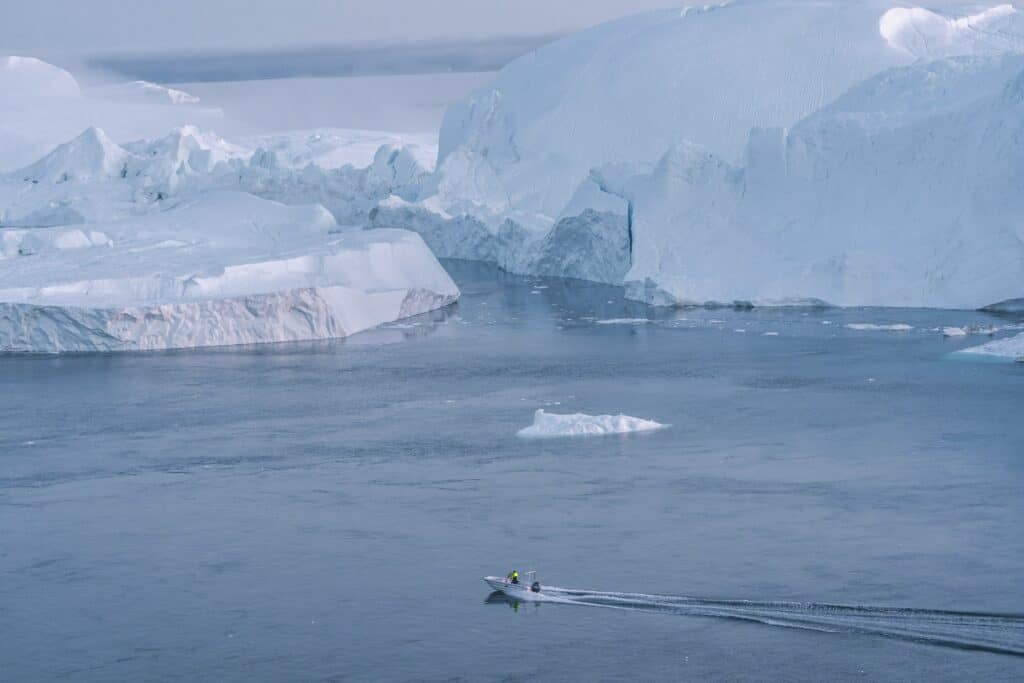
Ilulissat is a town on the southwest coast of Greenland, precisely in Disko Bay, only 561 kilometres north of Nuuk. It is the third largest town in the country by area, with a population of only 4600 people. Off the coast of this tiny town is the Ilulissat Icefjord.
Basically, a fjord is a deep narrow sea inlet with cliffs on both sides that extends for a certain length and eventually opens to the sea. An icefjord is one whose cliffs are made by a glacier.
The Jakobshavn Glacier, or Sermeq Kujalleq as the locals call it, is located in Disko Bay. It makes up 6.5% of the ice sheet that covers Greenland and from which 10% of the island’s icebergs separate. It is 110,000 square kilometres in area, 2,000 metres thick and over 65 km long. This glacier makes the Ilulissat Icefjord. Ilulissat is located precisely where the icefjord opens to the sea. In 2004 it was officially declared a UNESCO World Heritage Site.
In Ilulissat, one can go on a hiking adventure to explore this spectacular icefjord. There are two hiking trails along the fjord’s edge with different difficulties. The yellow trail is the shortest and easiest, with a length of 2.7 kilometres, while the blue one, the hardest, is seven kilometres.
Both trails show amazing scenes of the glacier. You get to see the inlet as you walk along, and if you are lucky enough, you may witness the glorious moment of an iceberg breaking off the glacier and moving under its own weight in the water, making huge waves. Such a phenomenon is called glacier calving, and the huge waves resulting from it are often called little tsunamis!
While it might not be very common as a travel destination, Greenland does make a unique one for everything one can experience there is quite unlike what most other countries are famous for. It is a distinctive spot where one can witness spectacular natural phenomena that reminds them of the magnificent planet we happen to live on yet, unfortunately, take for granted.






